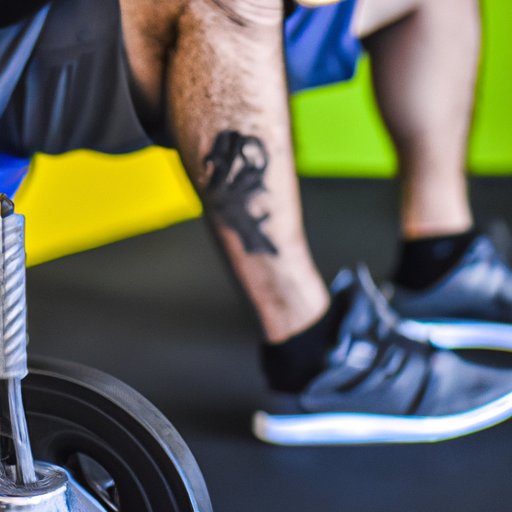Introduction
Getting a new tattoo can be an exciting time, but it’s important to remember that tattoos are essentially open wounds that require proper care to prevent infection and ensure proper healing. One of the most common questions people ask after getting a tattoo is whether they can exercise. The answer is yes, but with some important caveats. In this article, we will explore the dos and don’ts of exercising with new tattoos and provide tips and advice from tattoo artists and fitness professionals on how to stay active while protecting your new ink.
The Dos and Don’ts of Exercising with New Tattoos
Before diving into the specifics of working out with a new tattoo, it’s important to understand some general guidelines for caring for your tattoo. These guidelines will not only help your tattoo heal properly but will also help prevent possible infections and damage to your new ink. Some basic dos and don’ts include:
- DO keep your tattoo clean and moisturized
- DON’T expose your tattoo to direct sunlight or tanning beds
- DON’T go swimming or submerge your tattoo in water for at least two weeks
- DON’T pick or scratch at your tattoo
- DO follow any aftercare instructions provided by your tattoo artist
Is it Safe to Sweat with a New Tattoo? Tips for Staying Active
Sweating with a new tattoo can be concerning to some people, but sweating itself won’t damage the tattoo. However, it’s important to take precautions to avoid irritating the tattoo or putting it at risk of infection. Some tips for staying active while minimizing the risk of damage to your tattoo include:
- Wearing loose-fitting, breathable clothing during your workouts
- Using tattoo-specific aftercare products, such as moisturizer and ointment
- Avoiding activities that will cause friction or direct pressure on your tattoo
- Gently patting your tattoo dry if you do sweat during a workout
New Tattoos and Exercise: How to Balance Your Passion for Fitness with Proper Care
When you’re passionate about fitness, it can be difficult to take a break from your usual routine while your tattoo heals. However, it’s important to balance your love of exercise with proper care for your new ink. In the first few weeks after getting a tattoo, it’s essential to prioritize aftercare to ensure your tattoo heals properly. This might mean modifying your workouts or routines to avoid irritating the tattoo. Some specific examples of how to modify your workouts might include:
- Avoiding exercises that require heavy lifting, such as weightlifting
- Mixing up your routine to avoid doing the same movements repeatedly
- Using low-impact exercises, such as yoga or cycling, to avoid irritating the tattoo
- Taking rest breaks during high-intensity workouts to avoid sweating excessively
Can You Work Out After Getting Inked? Here’s What the Pros Say
Tattoo artists and fitness professionals have seen it all when it comes to clients who are eager to hit the gym after getting inked. So, what do the pros say? Generally speaking, it is safe to exercise after getting a tattoo, as long as you follow proper aftercare procedures. Some misconceptions that tattoo artists frequently hear include the idea that sweating will wash away the ink or that exercise will cause the tattoo to fade. These are not true – as long as you take proper care of your tattoo, exercise is perfectly fine.
Stay Fit While Protecting Your Tattoo: A Guide to Exercising with Fresh Ink
If you’re unsure how to modify your workouts to protect your new tattoo, don’t worry. There are plenty of ways to stay active and healthy while also taking care of your new ink. Some tips to help you balance exercise and aftercare while protecting your tattoo include:
- Choosing workouts that aren’t likely to cause irritation on the tattoo site
- Avoiding exercising in a way that will cause excessive sweating
- Taking rest breaks as needed during workouts to avoid overexertion
- Choosing clothing that won’t rub against your tattoo, such as loose-fitting tops or shorts
- Using tattoo-specific aftercare products to moisturize and protect your skin
The Best Types of Exercise to Do After Getting a Tattoo
While it’s generally safe to exercise after getting a tattoo, some types of exercise are less likely to cause irritation or damage to your new ink. Some low-impact exercises to consider for the first few weeks after getting a tattoo might include:
- Yoga or Pilates
- Walking or hiking
- Swimming (as long as you avoid submerging the tattoo)
- Cycling or using an elliptical machine
From Yoga to Running: How to Modify Your Workouts After Getting a New Tattoo
If your usual exercise routine involves higher-impact activities, such as running or weightlifting, it’s important to modify your workouts while your tattoo heals. However, that doesn’t mean you have to stop exercising altogether. Some tips for modifying specific types of workouts might include:
- Avoiding running or other high-impact activities that can cause the tattoo to rub against your clothing
- Using lighter weights and avoiding exercises that put direct pressure on the tattoo site
- Taking breaks as needed during cardio sessions to avoid sweating excessively
Conclusion
Exercising with a new tattoo requires some extra care and attention to ensure proper healing. Still, it’s possible to stay active and healthy while also protecting your new ink. By following proper aftercare procedures, modifying your workouts as needed, and choosing low-impact exercises that are less likely to cause irritation or damage to your tattoo, you can keep up with your fitness routine while also taking care of your new tattoo.
(Note: Is this article not meeting your expectations? Do you have knowledge or insights to share? Unlock new opportunities and expand your reach by joining our authors team. Click Registration to join us and share your expertise with our readers.)
